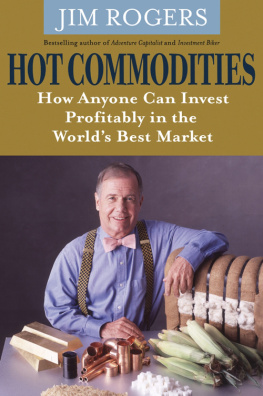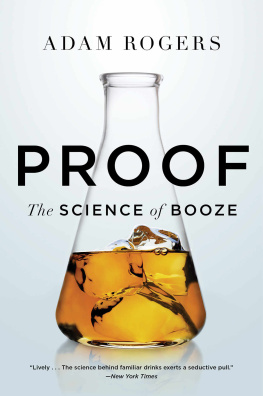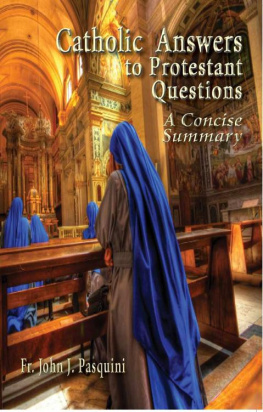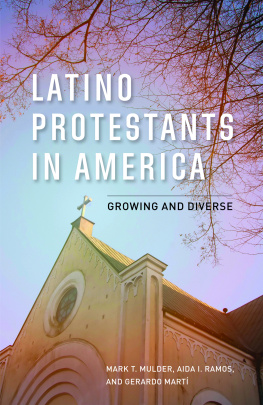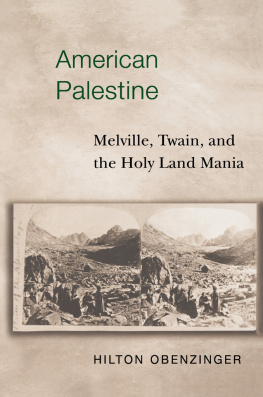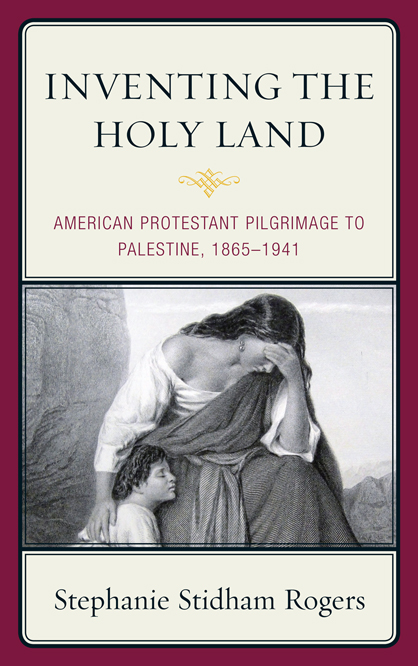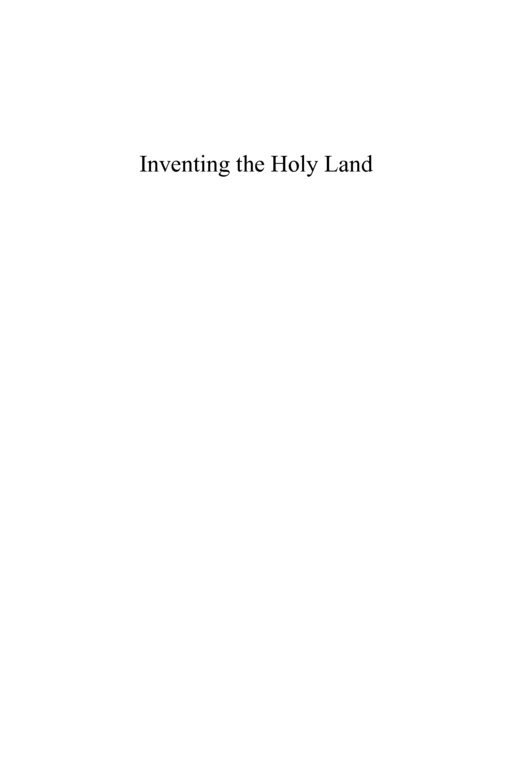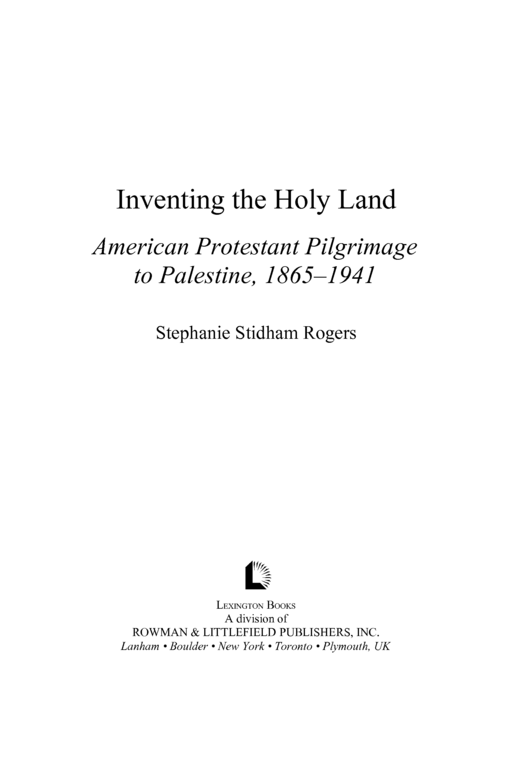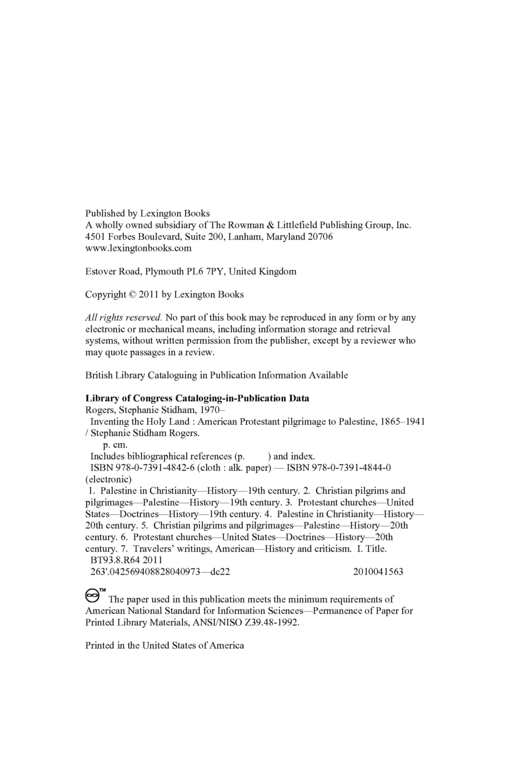Table of Contents
Acknowledgments
| 2 | American Protestants and Palestine |
| 3 | Protestants, Arabs, and Islam in the Holy Land |
| 4 | American Protestant Zionism and Pilgrimage Narratives |
| 5 | The Out-of-Doors Gospel in Palestine: Protestants Encounter Catholic and Orthodox Shrines and Create Their Own Traditions |
Bibliography
Index
About the Author
Acknowledgments
This book has been a project with many supporters to whom I must express my gratitude. Additionally, many other geographical factors enriched this project. For example, my experiences traveling through the Red and Black Sea regions during the 1980s, studying at Jerusalem University College for a semester in 1991, and living as an expatriate in Manila, Philippines from 2003 to 2005 opened my eyes to Eastern Islamic and Jewish cultures as well as to the role of tourism and package tours in forming enduring images of the East. Extended times overseas and the relationships that I formed there have allowed me to begin to understand and observe some of the forces that shape tourism and the power that travel narratives of the East and the Holy Land have had in shaping the history of American religion and opinion.
I believe that the significance of American Protestant pilgrimage to the Holy Land endures and that further study of the period that saw the birth of these tours is highly warranted. It is my hope that this book will contribute to a fuller analysis of the role of the Holy Land in the history of American Protestant thought and practice and that also in some small way it will foster conversation, understanding, and create new avenues of intercultural self-understanding. I have been guided and sustained by the belief that travel narratives were at least as widely read as novels during the nineteenth and early twentieth centuries and that their significance to religion and culture must be more carefully examined. Hence, I am grateful to my editor, Melissa Wilks, for choosing this manuscript for publication and for all of her support throughout the process.
This book would not be possible without all the institutional support that I have received throughout the years, for which I would like to express my gratitude. The Religious Studies and English Departments of Westmont College, with special mention of Robert Gundry, Paul Willis, Heather Spears, and Randall Vandermey, provided a dynamic and encouraging place for my intellectual and social development. Ken Patchett and Joan were always ready to examine and discuss new ideas as they arrived. The ongoing, fruitful relationship between Westmont College and Jerusalem University College also allowed me to spend an undergraduate semester abroad in Jerusalem in 1989 that sparked my interest in the history of Protestant pilgrimage and tourism, allowing me the latitude to grow experientially as well as intellectually. Thank you to the faculty and staff in Jerusalem who made sure than no stone was left unturned by our small but energetic class, and to Gabriel Barkay, Jim Monson, and Bill Schlegel for allowing our rowdy band of undergraduates to help out with the Ketef Hinnom dig in Jerusalem.
The American Church History program at Princeton Theological Seminary was also an incubator for the ideas that form this book, which started out as a PhD dissertation. Special thanks to James Deming, Richard Fenn, and James Moorhead for those critical times that they were able to encourage my ideas and provide support, and to Nancy Duff and David Mertz for their support at every stage. My research was also enabled and fostered by the dedicated labor of librarians and staff who serve at these institutions; and, to those who kindly read and commented on versions of my work, particularly my fellow doctoral students at Princeton Seminary, a special thank you. In recent years the vibrant faith community at St. Andrews Episcopal Church in Tampa under Rev. John Reese has provided much needed support at times, as have my in-laws, both the Duffs and the Rogers. Nancy and Craig Stevens in Tampa have helped to shore up the Davis Islands morale as the end approached. At the annual meeting of the American Society of Church History in 2003, there was a wonderfully serendipitous meeting with Carolyn DeSwarte Gifford, who generously rushed me her recent transcription of the unpublished Palestine journals of Frances Willard.
Most integral to the growth and completion of this book have been the members of my immediate family who have allowed me to follow my dreams and ideas. Grandparents Neil and Mildred Stidham, and Harold and Edna Patchett encouraged and provided opportunities for me over the course of many years while they were still here with us. Parents Howard and Rose gave me the gift of choices and options such as intellectual and geographical independence and mobility. Most importantly they taught me to trust my own voice and to attempt to seek truth independently, as well as persistence if promised supports for this project faltered. Siblings Robyn and Gwen have been both sisters and friends. My childrenLane and Sophiahave broadened the dimensions of my life, kept me grounded, and filled my life with love and joy. Christopher, my husband, has journeyed with me every step of the way on the wandering pilgrimage of this dissertation-turned-book even while walking his own path first as a student and later as a corporate executive. I am deeply happy for his love and support without which this book would not have been possible.
Chapter One
Introduction
Within this larger context of increased mobility and Western expansion, newly upwardly mobile American Protestant pilgrims journeyed to Palestine, the Christian Holy Land, and sought to claim spiritual and physical pieces of the ancient lands for their own. This book will focus on a specific phenomenon that occurred within the larger context of increased mobility and Western expansion, i.e., newly mobile American Protestant pilgrims traveling to Palestine (the Christian Holy Land) in search of a renewal and fulfillment of religious identity.
Missions to Palestine began to bear millennial hopes. As American Protestants both looked and traveled eastward, they sought out programs that would make Palestine more biblicalin an American, Western, Protestant sense of understanding the Bible. This book chronicles this new Holy Land Protestant pilgrimage trend of the nineteenth century and shows how Protestants reacted to Palestine by creating new sites there and mythologies that would make it more culturally familiar, in part as a way to cope with the paradoxes presented by the land.





